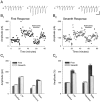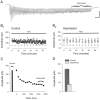Hippocampal long-term potentiation preserves the fidelity of postsynaptic responses to presynaptic bursts
- PMID: 9952401
- PMCID: PMC6786013
- DOI: 10.1523/JNEUROSCI.19-04-01236.1999
Hippocampal long-term potentiation preserves the fidelity of postsynaptic responses to presynaptic bursts
Abstract
Hippocampal cells often fire prolonged bursts of action potentials, resulting in dynamic modulation of postsynaptic responses; yet long-term potentiation (LTP) has routinely been studied using only single presynaptic stimuli given at low frequency. Recent work on neocortical synapses has suggested that LTP may cause a "redistribution of synaptic strength" in which synaptic responses to the first stimulus of a presynaptic burst of action potentials are potentiated with later responses depressed. We have examined whether this redistribution occurs at hippocampal synapses during LTP. Using prolonged bursts that result in maximal short-term depression of later responses within the burst, we found that LTP resulted in a uniform potentiation of individual responses throughout the burst rather than a redistribution of synaptic strength. This occurred both at Schaffer collateral-CA1 synapses and at CA3-CA3 synapses, the latter being activated and monitored using paired recordings. Thus in the hippocampus, LTP preserves the fidelity of postsynaptic responses to presynaptic bursts by a uniform increase rather than a redistribution of synaptic strength, a finding that suggests there are important differences between neocortex and hippocampus in how long-term changes in synaptic strength are used to encode new information.
Figures








Similar articles
-
Long-term change in synaptic transmission in CA3 circuits followed by spontaneous rhythmic activity in rat hippocampal slices.Neurosci Res. 2001 Aug;40(4):325-36. doi: 10.1016/s0168-0102(01)00244-9. Neurosci Res. 2001. PMID: 11463478
-
GABAB receptor- and metabotropic glutamate receptor-dependent cooperative long-term potentiation of rat hippocampal GABAA synaptic transmission.J Physiol. 2003 Nov 15;553(Pt 1):155-67. doi: 10.1113/jphysiol.2003.049015. Epub 2003 Sep 8. J Physiol. 2003. PMID: 12963794 Free PMC article.
-
Characterization of the anoxia-induced long-term synaptic potentiation in area CA1 of the rat hippocampus.Br J Pharmacol. 1997 Oct;122(4):671-81. doi: 10.1038/sj.bjp.0701409. Br J Pharmacol. 1997. PMID: 9375963 Free PMC article.
-
Involvement of postsynaptic G-proteins in hippocampal long-term potentiation.Rev Neurosci. 1994 Jan-Mar;5(1):1-9. doi: 10.1515/revneuro.1994.5.1.1. Rev Neurosci. 1994. PMID: 8019702 Review.
-
Theta-burst LTP.Brain Res. 2015 Sep 24;1621:38-50. doi: 10.1016/j.brainres.2014.10.034. Epub 2014 Oct 27. Brain Res. 2015. PMID: 25452022 Free PMC article. Review.
Cited by
-
Spike timing in CA3 pyramidal cells during behavior: implications for synaptic transmission.J Neurophysiol. 2005 Aug;94(2):1528-40. doi: 10.1152/jn.00108.2005. Epub 2005 May 4. J Neurophysiol. 2005. PMID: 15872069 Free PMC article.
-
Long-term potentiation and the role of N-methyl-D-aspartate receptors.Brain Res. 2015 Sep 24;1621:5-16. doi: 10.1016/j.brainres.2015.01.016. Epub 2015 Jan 22. Brain Res. 2015. PMID: 25619552 Free PMC article. Review.
-
Elevated NMDA receptor levels and enhanced postsynaptic long-term potentiation induced by prenatal exposure to valproic acid.Proc Natl Acad Sci U S A. 2007 Aug 14;104(33):13501-6. doi: 10.1073/pnas.0704391104. Epub 2007 Aug 3. Proc Natl Acad Sci U S A. 2007. PMID: 17675408 Free PMC article.
-
Modulation of transmission during trains at a cerebellar synapse.J Neurosci. 2000 Feb 15;20(4):1348-57. doi: 10.1523/JNEUROSCI.20-04-01348.2000. J Neurosci. 2000. PMID: 10662825 Free PMC article.
-
Superconducting Bio-Inspired Au-Nanowire-Based Neurons.Nanomaterials (Basel). 2022 May 13;12(10):1671. doi: 10.3390/nano12101671. Nanomaterials (Basel). 2022. PMID: 35630895 Free PMC article.
References
-
- Abbott LF, Varela JA, Sen K, Nelson SB. Synaptic depression and cortical gain control. Science. 1997;275:220–224. - PubMed
-
- Asztely F, Xiao MY, Gustafsson B. Long-term potentiation and paired-pulse facilitation in the hippocampal CA1 region. NeuroReport. 1996;7:1609–1612. - PubMed
-
- Bliss TV, Collingridge GL. A synaptic model of memory: long-term potentiation in the hippocampus. Nature. 1993;361:31–39. - PubMed
-
- Brenowitz S, David J, Trussell L. Enhancement of synaptic efficacy by presynaptic GABA(B) receptors. Neuron. 1998;20:135–141. - PubMed
Publication types
MeSH terms
LinkOut - more resources
Full Text Sources
Miscellaneous
